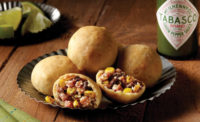When it comes to pizza, consumers aren’t lukewarm: Those who like it are committed to their favorite convenient meal. According to Mintel’s latest U.S. pizza market report, more than one-third of consumers who purchase frozen pizza from their local grocery store do so two or three times a month or more. Plus, premiumization in the category is leading to increased dollar sales, as three quarters of pizza consumers say they are willing to spend more on a better quality frozen pizza.
Overview | Bread | Tortillas | Sweet Goods | Snack Cakes | Pizza | Desserts | Cookies | Buns & Rolls | Bars | Breakfast Products
Market data
Indeed, frozen pizza is doing quite well, according to data from IRI, Chicago. Over the course of the 52 weeks ending March 25, 2018, sales of frozen pizza grew 3.15 percent overall to reach over $4.7 billion. And every single company in the top 10 saw growth.
Category leader Nestlé was up 1.14 percent to $2.0 billion, and its flagship brand, DiGiorno, grew 3.68 percent to $1.1 billion, per IRI. Other Nestlé brands on the upswing include Jack’s, up 2.42 percent to $260.3 million, and California Pizza Kitchen, up 6.30 percent to $155.3 million.
Other spots of notable growth in frozen pizza include private label up 11.09 percent to $627.7 million, Home Run Inn up 8.44 percent to $81.4 million, and Newman’s Own, up 11.51 percent to $64.0 million. Overall, Schwan Co. was relatively flat, up 0.87 percent to $861.7 million, but its Tony’s brand performed quite well, up. 21.42 percent to $97.3 million.
The frozen pizza crusts and dough segment saw some shakeups over the past year, with Boulder Brands dollar sales dropping 19.09 percent to $4.0 million, and private label growing 19.25 percent to $4.0 million. And newcomer CAULIPOWER made a significant splash in the segment, with sales of $2.1 million.
The up-and-down volatility of refrigerated pizza/kits and crusts/dough shows those segments in flux. The Champion Foods take-and-bake pizza brand Family Finest saw strong growth, up 21.79 percent to $7.9 million. Kraft Heinz growth comes courtesy of its Lunchables Uploaded brand, up 21.07 percent to $7.0 million. In refrigerated pizza crust/dough, the most-notable growth came from Wewalka, up 131.3 percent to $9.3 million.
Looking back
Randy Medina, pizza application specialist, Grote Co., Columbus, OH, says the frozen pizza market is growing for a few primary reasons. “Consumers are looking for convenience, while not sacrificing quality or flavor,” he says. “In response, our customers are producing a greater variety of pizzas with new and diverse ingredients.”
Mark Stavro, senior director of marketing, Bunge North America, Chesterfield, MO, notes that pizza isn’t going anywhere any time soon. “Demand for pizza is on the rise, which is no surprise as shoppers and diners increasingly seek a combination of convenience, indulgence and nutrition from individual food items. Pizza is an ideal carrier for on-trend toppings and ingredients, while still maintaining the level of familiarity that allows it to hold mass appeal.”
According to Nick Magistrelli, vice president of sales, Rademaker, Hudson, OH, the category continues to face perceptions that frozen pizza is a highly processed convenience food. In response, he says, pizza manufacturers are constantly having to look ahead to find the next best thing in freshness and clean-label trends. Currently, it’s all about the crust.
“While pizza has traditionally delivered flavor through toppings, the crust has become a key opportunity to differentiate on taste, as well as nutrition,” says Stavro. “For instance, ancient grains are gluten-free, offer a unique flavor profile, and can be incorporated in pizza crusts as flour or in a whole-grain format, or used as a dusting meal.” Bunge offers ancient grains like quinoa, millet and sorghum, which can be incorporated into the crust itself or used as whole-grain inclusions to add texture and taste—and a health halo.
Ardent Mills, Denver, has formed The Annex by Ardent Mills, an entire business division dedicated to new specialty grains, to meet this demand—for both retail and foodservice product developers. “Gluten-free dough formulations can include ancient grains such as quinoa, sorghum, amaranth, teff, and buckwheat,” says Zachery Sanders, director of marketing. He notes that these ancient grains can deliver new and exciting flavors and textures—tools to create something truly different and innovative.
Schwan Co., Marshall, MN, recently launched two new flavors of its frozen Freschetta Gluten Free Pizza: Spinach & Roasted Mushroom and Tuscan Style Chicken. These flavors also carry the refreshed “Kitchen Fresh” packaging design introduced by the brand November 2017, answering trends for artisan varieties.
The Quinoa Crisps from Ardent Mills have a light and crispy texture and work well in artisan-style pizza crusts. The company’s gluten-free Ancient Grain Blends and Nature’s Own Colored Barleys also make suitable additions to pizza dough.
The key is that these ingredients not only provide new and exciting flavors to pizza, but also touch on clean label and healthy trends, says Stavro. “While alignment with health and wellness objectives is key, people ultimately want their foods—especially indulgent foods like pizza—to taste good,” he says, “and ancient grains deliver on both fronts.”
Looking forward
The challenge with delivering new and innovative varieties, says Medina, is that ever-changing trends are causing brands to continually reformulate and reset. “A challenge will be keeping up with consumer demand that will continue to shift, and faster than we’ve seen in the past,” he says. In response, Grote has restructured its teams to specialize in specific markets, so engineers and sales team members alike can stay in touch with manufacturers on a day-to-day basis.
These trend shifts include considerable influence from millennials. “We’ve noticed the millennial generation is starting to impact the market,” says Gina Bolger, senior vice president of branding, Home Run Inn, Woodridge, IL. “They are crafting their own food culture with choices today tending to be healthier, more natural and less processed than prior generations. Home Run Inn is very excited about the influence this generation is having on the market, as they align well with what we believe in and who we are as a company. As a family business, we care most about the quality and freshness of our product.”
The good news is that suppliers and brands are up for the challenge. “The opportunities in the frozen and refrigerated pizza category are very promising,” says Magistrelli. “With the growing demand in Americans to be on the move and the rapid lifestyles that millennials live, there is an incredible future for this category to keep rising.”
Overview | Bread | Tortillas | Sweet Goods | Snack Cakes | Pizza | Desserts | Cookies | Buns & Rolls | Bars | Breakfast Products











